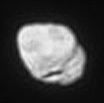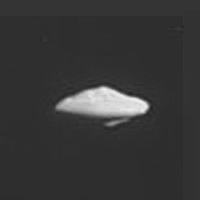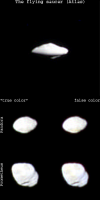Printable Version of Topic
Click here to view this topic in its original format
Unmanned Spaceflight.com _ Cassini's ongoing mission and raw images _ Rev 009 Observations
Posted by: Phil Stooke Jun 10 2005, 12:53 PM
Here's the latest Prometheus image... actually a composite of the four available when I got in to - uh - work.
I think we are looking at the anti-Saturn end, and down the leading side, from the south.
Phil
Posted by: Decepticon Jun 10 2005, 01:11 PM
http://saturn1.jpl.nasa.gov/multimedia/images/raw/raw-images-list.cfm?browseLatest=0&cacheQ=0&storedQ=0
Posted by: SFJCody Jun 10 2005, 01:20 PM
http://saturn.jpl.nasa.gov/multimedia/images/raw/casJPGFullS11/N00035256.jpg
So that's what happened to the frisbee I lost.
Posted by: Phil Stooke Jun 10 2005, 03:26 PM
And here's the new Atlas image, a composite of the three on the website this morning.
(maybe it should be upside down... this is probably the southern side)
Phil
Posted by: djellison Jun 10 2005, 03:54 PM
WOW - Hoagland will be having FITS over this one ![]()
Can we expect any closer approaches in the primary mission?
Doug
Posted by: SFJCody Jun 10 2005, 04:10 PM
31,400 km on 12 June 2007.
It's a pity there are no images from the Feb. 17, 2005 encounter (6,189 km)
Posted by: dvandorn Jun 10 2005, 05:58 PM
Wait a second -- that's the Jupiter II from the Lost in Space TV show!
I guess they're not lost anymore...
-the other Doug
Posted by: Mongo Jun 10 2005, 06:17 PM
It reminds me of the Mothership from the movie 'Independance Day'. I suppose that we all will have a much better view of it in three weeks. ![]()
Bill
Posted by: volcanopele Jun 10 2005, 06:33 PM
I know some have suggested that Iapetus' equatorial bulge was formed by infalling ring material. I never took much stock in it given Iapetus' size and current position (the latter can change though), but for the equatorial bulges of these Pan and Atlas, I don't see why that explanation can't work.
Posted by: tedstryk Jun 10 2005, 08:27 PM
Is the Hyperion set that is on the raw site complete? It seems all the images are overexposed. This is all I can get out of them.
Was this an attempt to look for comet-like activity or a mistake?
Posted by: volcanopele Jun 10 2005, 08:33 PM
They're not-overexposed, just poorly stretched by JPL. This tends to be a problem with bodies that take up only a small percentage of the image. the image you show is at ~4.5 km/pixel. We will get LOADS more over the next 3-4 days with the best images topping out at just under 1 km/pixel.
Posted by: alan Jun 10 2005, 08:48 PM
I expected the tide to orient Atlas so the long axis is pointed toward Saturn. Instead the long axis appears to parallel to its orbit. Is this just an effect of lighting and viewing angle or is something else responsible?
Posted by: tedstryk Jun 10 2005, 08:52 PM
Good to here. I look forward to seeing the images!
Posted by: Gsnorgathon Jun 10 2005, 11:23 PM
I'm with Alan. If the long axis doesn't point toward Saturn, what does that say about Atlas's composition?
Posted by: volcanopele Jun 10 2005, 11:26 PM
We already know that Atlas is a pretty porous body (at least Pan definitely is). But certainly there has to be some explanation for current orientation, either through ring impacts or perterbation from Prometheus.
Posted by: Sunspot Jun 10 2005, 11:42 PM
Atmospheric diffraction?
http://saturn.jpl.nasa.gov/multimedia/images/raw/raw-images-details.cfm?feiImageID=41650
Posted by: um3k Jun 10 2005, 11:46 PM
http://saturn.jpl.nasa.gov/multimedia/images/raw/raw-images-details.cfm?feiImageID=41650
No, atmospheric refraction.
Posted by: Decepticon Jun 11 2005, 01:53 AM
Wonder if we will see Hyperion data this weekend?
Very curious as to what this moon looks like close up.
Posted by: tedstryk Jun 11 2005, 02:39 AM
Here is a crude mosaic of some of the Dione images. Gosh it looks like Ariel.
http://img299.echo.cx/my.php?image=dionerev93dj.jpg
Posted by: Phil Stooke Jun 11 2005, 02:39 AM
Orientation can't be judged from one image, and I'm pretty sure the one resolved Voyager image shows a long axis pointing towards Saturn - consistent with that, anyway. I think we are seeing Atlas end-on here, or nearly so, and the dimension we don't see is the longer one towards Saturn. Anyway, bulk density or composition would not affect orientation.
Phil
Posted by: Phil Stooke Jun 11 2005, 03:49 AM
Hmmm... the least badly stretched of these new Hyperion images - those available to us as I write, taken from about 750 000 km, - look to me as if they show a couple of grooves or fractures. One roughly horizontal in the image, one roughly vertical, crossing near the center. (I'm away from my beloved Photoshop right now so I can't play with and post the pic). In a paper a few years ago I said I thought I could see grooves in the best Voyager images - very near the limit of resolution, so uncertain. But it will be interesting to see tomorrow's new images. Maybe they will confirm it... maybe not!
Phil
Posted by: Decepticon Jun 11 2005, 04:07 AM
From the current images I've noticed very little craters. Than again that could be from lack of resolution.
I expect some big surprises with the new images!
Posted by: alan Jun 11 2005, 05:06 AM
I did some reading on tidal forces. In addition to the tides that try to stretch an object toward and away from a planet there are weaker ones that squeeze it in the other directions. Applying this to Atlas I came up with this idea. Because of the tides material from the rings accumulates along its equator ( I'm calling the ends closest to and farthest from Saturn the poles for now ) It is less dense than Atlas so it is able to build up. Eventually it builds up enough that gravity tips Atlas so the longer end is again pointing toward Saturn. When this happens the tides pull the loose material off the new 'poles' because it is inside the roche limit. The material from the inside is moving too slow to stay at Atlas' radius so it falls a short distance in forming a thin ring. The material on the outside does the opposite. Applying the same to Pan could create the faint ring visible inside it.
Disclaimer: the above theory is based on a little information and a lot of imagination. Any similarity between it and reallity is purely coincidental. ![]()
Posted by: Decepticon Jun 11 2005, 05:16 AM
Looks like Hyperion Images are going up.
Anyone who is up tonight can keep an eye out!
http://saturn1.jpl.nasa.gov/multimedia/images/raw/raw-images-list.cfm?browseLatest=0&cacheQ=0&storedQ=0
Note : It's almost 24hrs since I first noticed images posted with broken links.
Does anyone see the images?
It's odd, descriptions are there but no pic?!
Posted by: SFJCody Jun 13 2005, 01:08 PM
Does anyone see the images?
It's odd, descriptions are there but no pic?!
They're here now. But even the close ones are poorly stretched.
Posted by: Phil Stooke Jun 13 2005, 01:23 PM
Here are some of the best new Hyperion images.
This looks like the side opposite that seen by Voyager, all new territory. Alas, no sign of the grooves I suspected... can't win them all. Lots of interesting dark crater floors though. That mottled appearance was just visible in Voyager images, but of course nothing like this.
Phil
Posted by: Decepticon Jun 13 2005, 01:25 PM
This really looks different than the other smaller moons.
Notice the dark Stuff at the bottom of the crater. Mmmm wonder what that is?
Wow!
Posted by: tedstryk Jun 13 2005, 02:05 PM
This looks like the side opposite that seen by Voyager, all new territory. Alas, no sign of the grooves I suspected... can't win them all. Lots of interesting dark crater floors though. That mottled appearance was just visible in Voyager images, but of course nothing like this.
Phil
I wonder what the mottled features are, particualarly the dark spots. I can't wait to see non-stretched versions. I think there are some hints of groves on the terminator in some images, such as http://saturn.jpl.nasa.gov/multimedia/images/raw/casJPGFullS11/N00035388.jpg
I think the jury is still out, at least until we have more complete coverage or more balanced versions of these images, although they certainly aren't huge on this part of Hyperion. I know it is superficial and that the composition and scale we are dealing with are incredibly different, but damn Hyperion looks like Phobos.
Posted by: Phil Stooke Jun 13 2005, 02:11 PM
Sorry to clutter things up but this is a more complete set of images from the Hyperion flyby.
Phil
Posted by: Patteroast Jun 13 2005, 03:54 PM
I don't know abouyt anyone else, but it looks like a negative of Phoebe to me. ![]()
Posted by: Sunspot Jun 13 2005, 04:29 PM
Few of the images show any detail at all ![]() ... is that the dreaded auto-contrast enhancement again?
... is that the dreaded auto-contrast enhancement again?
http://saturn.jpl.nasa.gov/multimedia/images/raw/raw-images-details.cfm?feiImageID=42159
Posted by: JRehling Jun 13 2005, 04:43 PM
This looks like the side opposite that seen by Voyager, all new territory. Alas, no sign of the grooves I suspected... can't win them all. Lots of interesting dark crater floors though. That mottled appearance was just visible in Voyager images, but of course nothing like this.
Phil
I think what we're seeing is that all of the images that AREN'T stretched too far in this jpg form happen to be UV images. In UV, icy craters show bright rims on the other moons too. So we may be seeing nothing unusual, with crater floors that are dark only in UV. We'll have to see how the, eg, red and green images appear when they are not stretched so poorly -- they may not show dark crater floors.
The baffling thing to me is that the distribution of crater sizes appears to be so tight. Maybe this is a product of the same selection bias as I noted above, but it looks to me like Hyperion was peppered with a lot of same-size impactors. Odd.
Posted by: volcanopele Jun 13 2005, 05:49 PM
In this sense, Hyperion reminds me of Janus, a relatively bright surface layer with a darker interior that is brought to the surface by impacts.
Posted by: volcanopele Jun 13 2005, 07:55 PM
http://saturn.jpl.nasa.gov/multimedia/images/raw/raw-images-details.cfm?feiImageID=42159
Unfortunately, in this case, they really are saturated
Posted by: volcanopele Jun 13 2005, 09:08 PM
The final set of Hyperion images are now online. These show Hyperion receding from Cassini.
http://saturn.jpl.nasa.gov/multimedia/images/raw/casJPGFullS11/N00035454.jpg
This image shows the region seen best by Voyager (not sure which one).
Posted by: um3k Jun 13 2005, 09:42 PM
(why is there no "crying" smilie?
Posted by: JRehling Jun 13 2005, 09:42 PM
Even though what I said was true, I've looked at Mimas in UV, and Hyperion's crater floors are darker than the intercrater surface (plains?), while on Mimas, the crater floors and intercrater terrain are about the same brightness, with inner rims of craters being much brigher. So Hyperion does seem to be different.
Posted by: Sunspot Jun 13 2005, 10:13 PM
They've made lots of observations of Hyperion that seem to have come out OK, what do you think went wrong?
Here are a few more shots that came out ok
http://saturn.jpl.nasa.gov/multimedia/images/raw/raw-images-details.cfm?feiImageID=42337
http://saturn.jpl.nasa.gov/multimedia/images/raw/raw-images-details.cfm?feiImageID=42320
http://saturn.jpl.nasa.gov/multimedia/images/raw/raw-images-details.cfm?feiImageID=42301
http://saturn.jpl.nasa.gov/multimedia/images/raw/raw-images-details.cfm?feiImageID=42293
Posted by: volcanopele Jun 13 2005, 10:50 PM
The brightness model for Hyperion was incorrectly applied, causing it to be underestimated. This led to the exposure times to be greater than they should have been. This is being resolved for September's flyby.
Posted by: dvandorn Jun 14 2005, 12:21 AM
A lot of those little craters make up very straight crater chains, too -- just like we've seen on some of the larger icy moons, like Rhea.
In fact, a *majority* of the craters of a given size range are located in crater chains.
I'm impressed by the two chains that form an "X" in the last image on the right. Is it possible that we've found Planet X, the source of the shaving cream atom?
-the other Doug
Posted by: Phil Stooke Jun 14 2005, 03:57 AM
At first I thought those crater chains might be imaginary... then I looked more closely and yes, there do seem to be a lot. But we have to be wary of our uncanny ability to see patterns in randomness. I don't think this is all random, I agree there are crater chains... but maybe not all of them are significant alignments. But let's see what the September images show us...
But despite a few scattered and disorganized grooves on Ida, Gaspra, Eros etc., so far Phobos is still unique for its extraordinary system of grooves. I would still place Hyperion more in the Gaspra class of grooved bodies, from what I have seen so far.
Phil
Posted by: dilo Jun 14 2005, 06:34 AM
This is an animation of the best (UV filter) Hyperion sequence, with each frame resized in order to have same scale...
http://img91.echo.cx/img91/4821/hyperion8dl.gif
below also a couple of stereo (cross-eye) images:
http://img296.echo.cx/my.php?image=hypstereo14jj.jpg
http://img296.echo.cx/my.php?image=hypstereo34rm.jpg
Posted by: Decepticon Jun 14 2005, 10:48 PM
I for one think Hyperion looks unique.
Looking forward to the next flyby.
Posted by: MizarKey Jun 15 2005, 09:41 PM
Hyperion reminds me a bit of Eros, though it's not as peanut shaped.
Eric P / MizarKey
Posted by: dilo Jun 18 2005, 08:47 PM
A nice portrait of Ephimeteus and Pan (on the left):
http://img78.echo.cx/my.php?image=panepim6fm.jpg
Powered by Invision Power Board (http://www.invisionboard.com)
© Invision Power Services (http://www.invisionpower.com)


